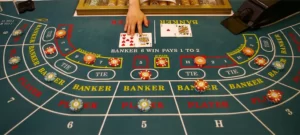It is hard to find a game that could better combine calculation and pure luck than Baccarat. Few people know, but originally it was a game exclusively for the nobility. For a long time it remained a mysterious amusement, hidden behind the curtains of private clubs and elite casinos. Today everyone can plunge into this mysterious world where betting on the Player, the Banker or the Draw decides outcomes as fast as life itself. And to understand the game on a deep level, you will need more than just knowledge of the rules of baccarat – you will need the ability to see behind the cards not only numbers, but also opportunities

Baccarat – logic versus intuition
Baccarat is not just a game of cards, but a battle of two approaches to life: calculated logic and unbridled luck. It starts with players betting on the outcome: who will win – the Player or the Banker, or perhaps there will be a Draw. After that, cards are dealt, and each card is not just an image, but a key to success or failure.
The goal is to build a hand as close to 9 as possible. Players are not directly involved in the deal and decision-making process – they rely on their intuition and belief in a certain outcome. And this is the main difference between baccarat and many other games – there is more trust in fate than in your influence on it.
Betting options – diving into the world of choice
 Player Bet: With no commissions or complications, a Player bet simply pays out a 1:1 win. But it’s important to remember that the decision requires some trust in luck, as the odds are slightly lower than the Banker.
Player Bet: With no commissions or complications, a Player bet simply pays out a 1:1 win. But it’s important to remember that the decision requires some trust in luck, as the odds are slightly lower than the Banker.- Banker’s Bet: A bet with a mathematical advantage. A 1:1 payout is accompanied by a 5% retention fee. This is not a big deal, as betting on the Banker has historically resulted in a win more often than not.
- Betting on a Draw: High risk but also high reward – payout 8:1. Why such high odds? Because the odds of a draw are so small that if it happens, it is a truly rewarding event.
What do the cards mean in baccarat?
To understand the rules of baccarat, you need to understand the cards. Each card is not just a denomination, but a whole philosophy:
- Ace – symbolises the beginning and gives 1 point;
- cards from 2 to 9 – everything is very honest here: each card has its own nominal value;
- tens and pictures – a strange combination of power and nothingness. Everything that seemed powerful in other games is zero here.
Why is that? Perhaps because Baccarat teaches us: sometimes it is better to be small but significant than powerful but useless.
How to calculate the total amount?
To understand the calculation, imagine that the game is not about addition, but about simplicity. For example, if you have 7 and 9 in your hand, it will give 16. But baccarat does not tolerate large numbers, so only the last digit is taken – the total will be 6.
How the game is played – breakdown of each stage
The Player and the Banker are dealt two cards each. This is the whole point – the first deal sets the mood. If the Player has a sum of cards from 0 to 5 – the third card is dealt. If he has a 6 or 7, he keeps his cards. And if he is lucky enough to get an 8 or 9 – it is called a “natural” hand, and nobody takes anything else.
Dealing the third card – when the rules get complicated
If the third card is dealt, the Banker decides whether to take another card. Here everything depends on the amount in hand of the Banker and the values of the Player’s cards. Decisions are made strictly according to the rules, which look complicated, but the dealer handles this automatically. This is the moment when logic prevails over chaos.
Dealer actions – who really rules the game?
The dealer is the true master of the game, who does not make decisions based on emotions. Every action is dictated by strict rules that do not depend on what cards are on the table. This is what makes baccarat so predictable and fair – there is no room for personal preferences, only the algorithm.
Baccarat Rules for Player and Banker – analysing hand differences
The player moves first and takes his actions based on simple rules. If the sum of two cards is between 0 and 5, he gets a third card. If the sum is 6 or 7, he stays where he is. This makes the game for the Player’s hand predictable.
The Banker has the advantage that his turn is the second. This allows him to see what moves the Player is making and then act. For example, if the Banker’s card total is 5 and the Player’s third card is 4, the Banker must take another card. But if the sum is 7, the Banker stays.
Why does betting on Banker win more often?
The advantage of the Banker is due to the fact that he acts after the Player. He can make decisions knowing the Player’s hand, which increases the chances of winning. This is why there is a commission on the Banker bet – the casino needs to balance this preponderance.
Who becomes a winner in baccarat according to the rules of the game
A natural hand is a hand whose sum is 8 or 9 on two cards. If such a hand appears, the hand is automatically stopped. A natural 9 always beats a natural 8, which makes it the goal of any game.
The process of comparing hands
After all cards have been dealt, the Player’s and Banker’s hands are compared. The winner is determined by the one whose sum is closer to 9. In case of equality a draw is declared, which of course is a rare event, but in baccarat it is always a holiday for those who took the risk.
Commission on the Banker’s rate
A 5% commission is deducted when winning a bet on Banker. This fee is a kind of odds equaliser that balances the odds in favour of the Banker.

Conclusion
 Now that you know the basic rules of baccarat, you can try your hand at one of the online casinos. Take with you a good mood, attentiveness and a desire to win. It is quite possible that luck will be on your side.
Now that you know the basic rules of baccarat, you can try your hand at one of the online casinos. Take with you a good mood, attentiveness and a desire to win. It is quite possible that luck will be on your side.
 en
en  ru
ru  de
de  ar
ar  es
es  nl
nl  hi
hi  fr
fr  it
it  pt
pt  el
el 



